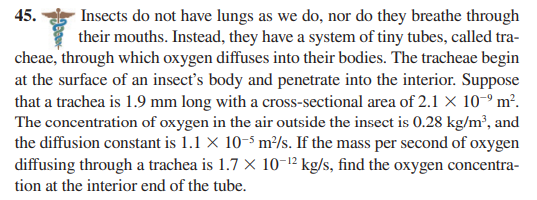45. Insects do not have lungs as we do, nor do they breathe through their mouths. Instead, they have a system of tiny tubes, called tra- cheae, through which oxygen diffuses into their bodies. The tracheae begin at the surface of an insect's body and penetrate into the interior. Suppose that a trachea is 1.9 mm long with a cross-sectional area of 2.1 × 10-º m². The concentration of oxygen in the air outside the insect is 0.28 kg/m², and the diffusion constant is 1.1 × 10-5 m²/s. If the mass per second of oxygen diffusing through a trachea is 1.7 X 10-12 kg/s, find the oxygen concentra- tion at the interior end of the tube.
45. Insects do not have lungs as we do, nor do they breathe through their mouths. Instead, they have a system of tiny tubes, called tra- cheae, through which oxygen diffuses into their bodies. The tracheae begin at the surface of an insect's body and penetrate into the interior. Suppose that a trachea is 1.9 mm long with a cross-sectional area of 2.1 × 10-º m². The concentration of oxygen in the air outside the insect is 0.28 kg/m², and the diffusion constant is 1.1 × 10-5 m²/s. If the mass per second of oxygen diffusing through a trachea is 1.7 X 10-12 kg/s, find the oxygen concentra- tion at the interior end of the tube.
College Physics
1st Edition
ISBN:9781938168000
Author:Paul Peter Urone, Roger Hinrichs
Publisher:Paul Peter Urone, Roger Hinrichs
Chapter12: Fluid Dynamics And Its Biological And Medical Applications
Section: Chapter Questions
Problem 7PE: (a) As blood passes through the capillary bed in an organ, the capillaries join to form venules...
Related questions
Question

Transcribed Image Text:45.
Insects do not have lungs as we do, nor do they breathe through
their mouths. Instead, they have a system of tiny tubes, called tra-
cheae, through which oxygen diffuses into their bodies. The tracheae begin
at the surface of an insect's body and penetrate into the interior. Suppose
that a trachea is 1.9 mm long with a cross-sectional area of 2.1 × 10-º m².
The concentration of oxygen in the air outside the insect is 0.28 kg/m², and
the diffusion constant is 1.1 × 10-5 m²/s. If the mass per second of oxygen
diffusing through a trachea is 1.7 X 10-12 kg/s, find the oxygen concentra-
tion at the interior end of the tube.
Expert Solution
This question has been solved!
Explore an expertly crafted, step-by-step solution for a thorough understanding of key concepts.
This is a popular solution!
Trending now
This is a popular solution!
Step by step
Solved in 2 steps

Recommended textbooks for you

College Physics
Physics
ISBN:
9781938168000
Author:
Paul Peter Urone, Roger Hinrichs
Publisher:
OpenStax College

College Physics
Physics
ISBN:
9781305952300
Author:
Raymond A. Serway, Chris Vuille
Publisher:
Cengage Learning

College Physics
Physics
ISBN:
9781285737027
Author:
Raymond A. Serway, Chris Vuille
Publisher:
Cengage Learning

College Physics
Physics
ISBN:
9781938168000
Author:
Paul Peter Urone, Roger Hinrichs
Publisher:
OpenStax College

College Physics
Physics
ISBN:
9781305952300
Author:
Raymond A. Serway, Chris Vuille
Publisher:
Cengage Learning

College Physics
Physics
ISBN:
9781285737027
Author:
Raymond A. Serway, Chris Vuille
Publisher:
Cengage Learning

University Physics Volume 1
Physics
ISBN:
9781938168277
Author:
William Moebs, Samuel J. Ling, Jeff Sanny
Publisher:
OpenStax - Rice University